What are the fundamentals of blockchain architecture?
Blockchain architecture refers to the underlying structure and design principles that govern how a blockchain system operates. At its core, a blockchain is a distributed digital ledger that records transactions across multiple computers in a way that ensures security, transparency, and immutability. Unlike traditional databases that rely on a centralized server, blockchain distributes the control and storage of data across a network of nodes, each having equal authority. This decentralized design eliminates the need for intermediaries, making the system more efficient and secure.

Importance in Various Industries
The blockchain has transcended its initial application in cryptocurrencies to become a foundational technology for various industries. In finance, it’s revolutionizing the way transactions are conducted and assets are managed, offering a more transparent and secure alternative to traditional banking systems. Healthcare is another sector where blockchain’s immutable and transparent characteristics are invaluable for maintaining patient records, thereby enhancing data integrity and confidentiality.
The supply chain industry is also leveraging blockchain architecture to improve transparency and traceability from production to delivery. This ensures the authenticity of products and helps in reducing fraud. Even in the realm of intellectual property and digital rights management, blockchain offers a way to transparently and immutably record ownership data. Its versatility and adaptability make it a technology that holds the promise to disrupt traditional operational frameworks across a wide range of sectors.
Decentralization and Distribution
One of the most defining characteristics of blockchain architecture is its decentralized nature. In a decentralized system, no single entity has complete control over the entire network. Instead, control is distributed among multiple nodes, each of which participates in the validation and recording of transactions. This decentralization enhances the system’s resilience against failures and attacks. If one node goes down, the network continues to function, ensuring uninterrupted service.
The distributed aspect of blockchain architecture further amplifies its robustness. Data is not stored on a single server but is replicated across multiple nodes in the network. This not only ensures data availability but also enhances security. Since each node has a copy of the entire blockchain, altering data would require changing it on the majority of nodes, a feat nearly impossible to achieve without being detected. This combination of decentralization and distribution is what sets blockchain architecture apart from traditional centralized systems, making it a more reliable and secure option for various applications.
What are the five architectural components of a blockchain?
Understanding Nodes
Nodes are the backbone of any blockchain architecture, serving as the individual points in the network that validate and relay transactions. In essence, a node is a computer connected to the blockchain network, running the software that allows it to perform these tasks. Each node has a copy of the entire blockchain, ensuring that the system remains decentralized and that no single point of failure exists. This redundancy is crucial for maintaining the integrity and availability of the data stored on the blockchain.
The role of nodes extends beyond just storing data, they also participate in the consensus process, which is essential for validating transactions and adding new blocks to the chain. Depending on the blockchain, nodes can be categorized into different types, such as full nodes, which store the complete blockchain history, and light nodes, which store only a subset of the blockchain, making them faster but less robust in terms of validation capabilities.
The Role of Transactions
Transactions are the fundamental actions executed on a blockchain network. Whether it’s transferring cryptocurrency, executing a smart contract, or recording data, every operation boils down to a transaction. Transactions are initiated by users and then broadcast to the network, where they are picked up by nodes for validation. Once validated, these transactions are grouped together into a block, awaiting addition to the blockchain.
The integrity of transactions is maintained through cryptographic techniques. Each transaction is signed with a digital signature, providing proof of its origin. This ensures that once a transaction is added to the blockchain, its history and authenticity can be verified by any node in the network, thereby enhancing transparency and trust.
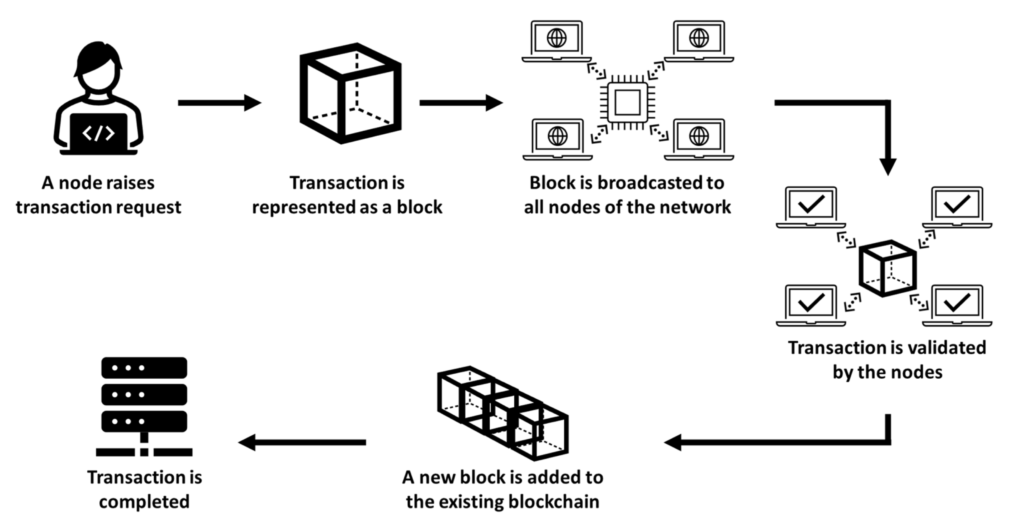
- A node (depicted as a person with code symbols) raises a transaction request.
- This transaction is then encapsulated and represented as a block (visualized as a 3D cube).
- This block is then broadcast to all nodes in the network (shown as multiple computers interconnected).
- The transaction within the block undergoes validation by all the nodes in the network. This is shown by tick marks on the computer screens.
- Upon successful validation, a new block is added to the existing blockchain (illustrated as a chain of 3D cubes).
- Finally, the transaction is marked as completed, visualized by a server or data stack.
What is a Block?
A block is essentially a container that holds a list of transactions. Once a certain number of transactions are validated, or a specific time limit is reached, these transactions are bundled into a block. Each block contains a header that holds metadata, such as the timestamp of its creation and a cryptographic hash linking it to the previous block in the chain. This linking of blocks through cryptographic hashes is what forms the “chain” in blockchain.
The block also contains a unique identifier known as the “block hash,” generated using the transaction data and the header information. This hash serves as a fingerprint for the block, ensuring its uniqueness and immutability. If any transaction within the block is altered, the block hash would change, signaling potential tampering and triggering further verification.
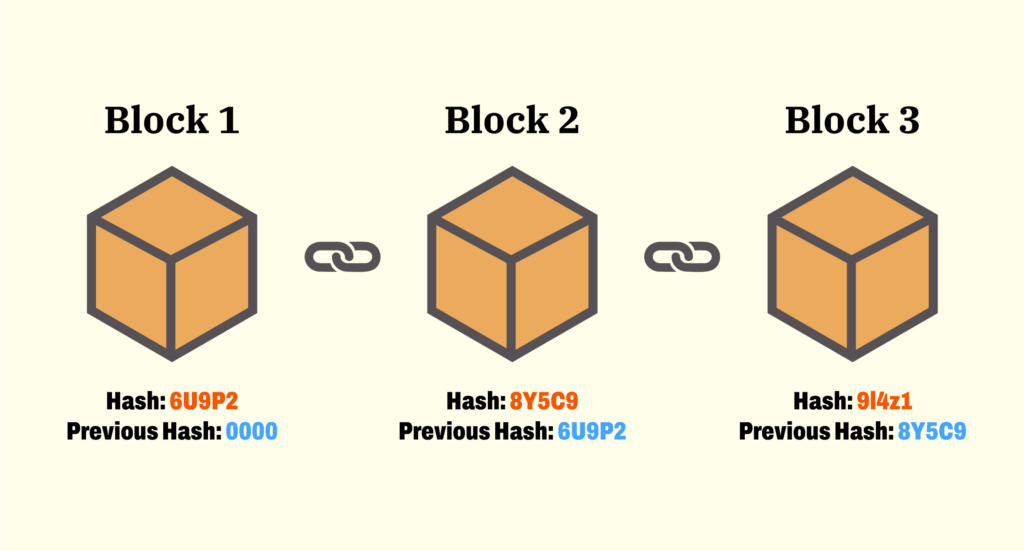
The Chain Explained
The “chain” in blockchain is a linear, chronological sequence of blocks, each linked to its predecessor through cryptographic hashes. This chain serves as the public ledger of all transactions that have ever occurred on the network. The very first block in the chain is known as the “Genesis Block,” and every subsequent block references the hash of the block that came before it. This creates an interdependent chain where altering one block would require altering all subsequent blocks, making the blockchain highly secure against tampering.
The chain is maintained by nodes, and each node has an identical copy of the chain. This distributed nature of the chain ensures that no single entity has control over the blockchain, reinforcing its decentralized and democratic ethos. It also provides multiple points of verification, making the blockchain incredibly resilient and reliable.
Miners and Consensus Algorithms
Miners play a pivotal role in the functioning of a blockchain network. These specialized nodes are responsible for validating transactions and creating new blocks, a process commonly referred to as “mining.” The mining process involves solving complex mathematical problems, known as cryptographic puzzles, to find a new block, which is added to the blockchain. This computational work is not just a random exercise; it serves to validate and secure transactions, making the blockchain resistant to fraud and malicious attacks. Miners are compensated for their computational efforts through a reward system, typically receiving a combination of newly minted cryptocurrency and transaction fees.
The reward system serves as an incentive mechanism, encouraging more participants to become miners. This, in turn, enhances the network’s security and integrity. The rewards are usually in the form of the blockchain’s native cryptocurrency, making the mining process intrinsically tied to the economic model of the blockchain. For instance, in the Bitcoin network, miners are rewarded with Bitcoin; in the Ethereum network, the reward is in Ether. This incentivization model ensures that miners are economically invested in the proper functioning of the network, aligning their interests with those of the broader community.

Consensus algorithms are the rules and protocols that govern how these miners reach an agreement, or consensus, about the state of the blockchain. The most prevalent consensus algorithms are Proof of Work (PoW) and Proof of Stake (PoS). In a PoW system, miners compete to solve a cryptographic puzzle, and the first to solve it gets to add the new block and receive the reward. However, this method is computationally intensive and energy-consuming. PoS, on the other hand, chooses validators based on the number of coins they hold and are willing to “stake” as collateral. It’s generally considered more energy-efficient and encourages long-term investment in the cryptocurrency.
Both PoW and PoS have their merits and limitations. PoW’s computational complexity makes it secure but energy-inefficient, raising environmental concerns. PoS is more energy-efficient but introduces other challenges, such as the potential for centralization if a few wealthy nodes dominate the staking process. Despite these challenges, consensus algorithms are the linchpin that holds the decentralized blockchain network together. They ensure that all transactions are agreed upon and recorded in a manner that is transparent, immutable, and secure, reinforcing the foundational principles of blockchain architecture.
Decoding the Different Types of Blockchain Architecture: Public, Private, and Consortium
Blockchains come in various categories, each with its unique features. The main distinctions are between public blockchains, open to everyone, and private ones restricted to specific entities. There are also hybrid blockchains, combining elements of both. Each of these types of blockchain caters to different needs, from transparency to confidentiality.
Public Blockchain Architecture
Definition: A public blockchain is an open, decentralized network that allows anyone to participate.

- Open Participation: Anyone can join and participate in the network.
- Decentralization: Nodes distributed globally maintain the network with no central authority.
- Security: Typically secured through consensus algorithms like Proof of Work (PoW). Transactions are immutable once added.
- Transparency: All transactions are publicly viewable.
- Vulnerability: Open nature could allow bad actors to attempt exploitation, although decentralization often mitigates this.
- Examples: Bitcoin, Ethereum.
Private Blockchain Architecture
Definition: A private blockchain is a restricted, centralized network managed by a single entity or organization.

- Restricted Participation: Only authorized entities can join.
- Centralization: Controlled by a single organization or entity.
- Privacy: Transactions are visible only to authorized participants.
- Efficiency: Faster transaction processing due to fewer validators.
- Trust Concerns: Centralized nature raises questions about trust in the managing entity.
- Examples: Hyperledger Fabric, Corda.
Consortium Blockchain Architecture
Definition: A consortium blockchain is a semi-private network governed by a collective group of organizations.

- Limited Participation: Access is granted to specific organizations.
- Joint Control: Governed by a group of entities, not a single one.
- Privacy: Similar to private blockchains, transactions are not publicly viewable.
- Efficiency: Offers quicker transactions than public blockchains, but with shared governance.
- Balanced Risk: Minimizes risk of single point of control and manipulation.
- Examples: Quorum, R3’s Corda.
Data Structures in Blockchain
Pointers and Their Role
Pointers in blockchain are like signposts that guide you through a maze. They’re used to link blocks together in a chain, showing where each block should go next. When a new block is created, it includes a pointer to the previous block, creating a chain of blocks that can be traced all the way back to the first one, known as the Genesis Block. This is crucial because it ensures that all transactions are kept in the right order, making it super hard for anyone to mess with past transactions.
But pointers aren’t just about keeping things in order; they’re also about security. Because each block points to its predecessor, changing one block would mean having to change every single block that comes after it. That’s a lot of work and computational power, making it practically impossible for anyone to alter the blockchain. So, in a way, pointers are the glue that holds the blockchain together, ensuring both its integrity and its security.

Linked Lists in Blockchain
Linked lists are the backbone of blockchain data structures. Imagine a chain of paperclips, each linked to the next. In blockchain, each “paperclip” is a block, and they’re all connected in a linear sequence. This is what we call a linked list. It’s a simple yet powerful way to keep data organized and secure. Each block contains a list of transactions, and these blocks are linked in a chronological order, forming a historical record of all transactions.
The beauty of using linked lists in blockchain is that it makes the data structure incredibly flexible yet secure. You can easily add new blocks to the end of the chain without affecting the previous ones. And because each block is connected to the one before it, the entire chain remains secure. If you try to tamper with one block, the links break, and the network quickly spots the anomaly. It’s a straightforward but effective way to keep things both organized and secure.

Understanding Block Headers
Block headers are like the ID badges for blocks in a blockchain. Each block header contains essential information that identifies the block, like its version, timestamp, and most importantly, its cryptographic hash. This hash is unique to each block and serves as its fingerprint. If anything within the block changes, the hash changes too, alerting the network to possible tampering.
But that’s not all. The block header also contains a reference to the hash of the previous block, creating a chain of blocks. This is where pointers come into play again, linking each block to its predecessor. The block header ensures that each block is unique, securely linked to the previous block, and resistant to tampering. It’s like the control center of each block, holding all the critical data that keeps the blockchain secure and functional.

Cryptographic Hashes and Merkle Root
Cryptographic hashes are the secret sauce that makes blockchain so secure. They take the data in a block and turn it into a string of numbers and letters, a unique identifier. If even a single character in the block changes, the hash changes dramatically, making it easy to spot any funny business. The Merkle Root is a special kind of cryptographic hash. It’s created by hashing all the transaction hashes in a block, producing a single hash that represents the entire set of transactions.
The Merkle Root is stored in the block header, serving as a compact summary of all transactions in the block. This is super handy because it allows you to verify a single transaction without having to look at every transaction in the block. It’s like having a table of contents that tells you exactly where to find what you’re looking for. This combination of cryptographic hashes and the Merkle Root provides a robust layer of security and efficiency, making blockchain a reliable and speedy way to handle data.
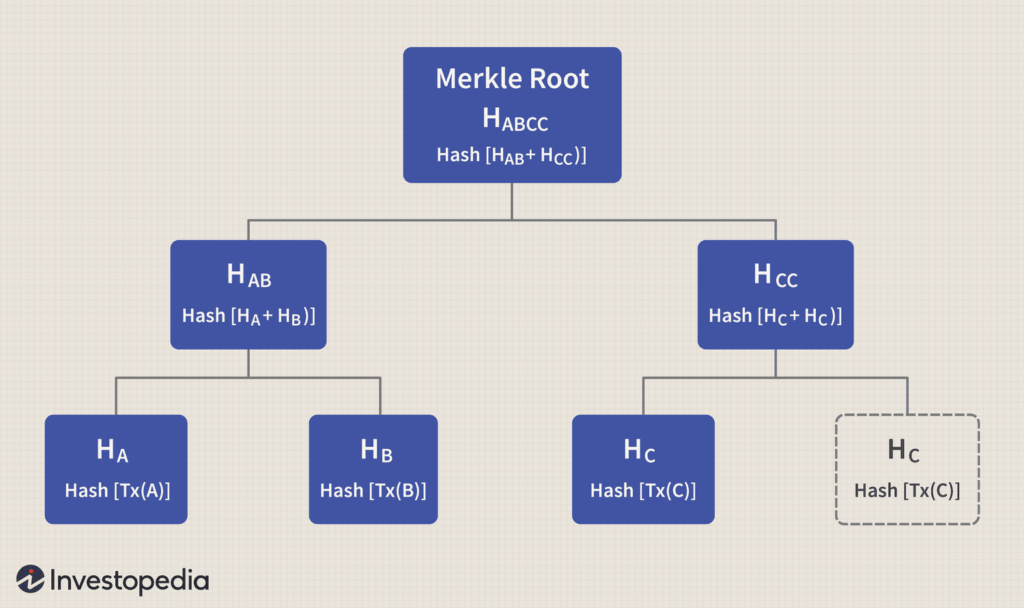
Building Your Own Blockchain Architecture
Open-source Solutions
So, you’re thinking about building your own blockchain? Awesome! The good news is you don’t have to start from scratch. There are plenty of open-source solutions out there that provide the building blocks for your blockchain project. These platforms offer pre-designed templates and frameworks that you can customize to fit your specific needs. It’s like getting a Lego set with all the pieces you need; all you have to do is put them together in a way that makes sense for your project.
Open-source solutions are a game-changer because they save you time and resources. You get to leverage the collective wisdom of a community of developers who have been there, done that. Plus, these platforms are often well-documented and supported, meaning you’ll find plenty of tutorials and forums to help you out if you get stuck. So, if you’re new to the blockchain world or just want to speed up the development process, going open-source is a smart move.
For instance, if you’re looking to create a decentralized marketplace, you might opt for Ethereum because of its robust support for smart contracts. Ethereum’s open-source community is teeming with developers who have built similar projects, and you’ll find a wealth of pre-existing code snippets and smart contract templates that you can adapt for your marketplace. This not only speeds up the development process but also provides you with tested and community-vetted solutions, making your blockchain more reliable and secure.
Hyperledger, Ethereum, and Corda
When it comes to open-source platforms for building blockchains, three names often pop up: Hyperledger, Ethereum, and Corda. Hyperledger is like the Swiss Army knife of blockchain; it’s versatile and designed for enterprise solutions. It’s great for creating private or consortium blockchains where you need a bit more control. Ethereum is the go-to for decentralized applications (dApps) and smart contracts. If you’re looking to build something that’s open to everyone and runs on a public blockchain, Ethereum is your best bet.
Corda is a bit different; it’s designed specifically for the financial sector. It’s like the Wall Street of blockchain platforms, focusing on things like asset management and smart contracts in a business-to-business setting. Each of these platforms has its own set of tools and features, so your choice will depend on what exactly you’re looking to do. Whether it’s creating a supply chain tracking system, a decentralized social network, or a digital asset management platform, one of these platforms will likely have what you need.
Creating Smart Contracts and Chaincode
Smart contracts are like self-executing digital agreements. Imagine setting up a vending machine: you put in money, make a selection, and the machine automatically gives you what you paid for. That’s how smart contracts work; they automatically execute predefined actions when certain conditions are met. They’re super useful for automating processes and ensuring that all parties stick to their end of the bargain.
Chaincode is another cool feature you can add to your blockchain. Think of it as the business logic of your blockchain, the rules that govern how transactions are processed. It’s like the instruction manual for your blockchain, telling it how to handle different types of transactions. Whether you’re setting up a voting system, a supply chain tracker, or a digital marketplace, smart contracts and chaincode give you the tools to make your blockchain do exactly what you want it to do. With these features, you can create a blockchain that’s not just secure and transparent but also incredibly versatile and efficient.
Benefits and Challenges
Cost-Effectiveness
Blockchain technology is often hailed as a cost-effective solution for various applications, from supply chain management to financial transactions. Imagine running a global business with multiple suppliers, distributors, and customers. Traditionally, you’d spend a fortune on intermediaries like banks, auditors, and legal services to ensure everything runs smoothly. With blockchain, you can cut out many of these middlemen. It’s like having a self-operating, automated system that everyone trusts, reducing the need for third-party verification and, consequently, lowering costs.
However, it’s worth noting that the initial setup of a blockchain can be expensive, especially for small businesses. You’ll need to invest in the technology, possibly hire blockchain experts, and spend time educating your team. But once it’s up and running, the long-term cost savings can be significant. For example, using a blockchain for supply chain management can drastically reduce the costs associated with tracking goods, verifying transactions, and managing inventory.
Transparency and Security
One of the standout features of blockchain is its ability to offer both transparency and security. It’s like having a public ledger that’s locked in a high-security vault. Every transaction is recorded and visible to all participants, but altering any data is nearly impossible. This makes it incredibly useful for applications where trust is crucial but difficult to establish. For instance, in a voting system, blockchain can ensure that each vote is both transparently recorded and securely stored, making electoral fraud extremely difficult.
But this transparency can sometimes be a double-edged sword. While it’s great for preventing fraud and enhancing accountability, it can also pose privacy concerns. For example, in a public blockchain, transaction details are visible to anyone who wants to see them. This could be problematic in cases where financial or personal data needs to be confidential.
Challenges and Solutions
While blockchain offers numerous benefits, it’s not without its challenges. Scalability is a big one. As more transactions are added to a blockchain, it can become slower and consume more energy, especially in Proof of Work systems. It’s like a growing city facing traffic jams; the more cars (or transactions), the more congested the roads (or blockchain). Solutions like layer 2 protocols and sharding are being developed to address this issue, aiming to increase the number of transactions that can be processed per second.
Another challenge is regulatory uncertainty. Since blockchain is a relatively new technology, laws and regulations are still catching up. This can make it risky for businesses to fully commit to blockchain solutions. However, as the technology matures and gains more mainstream acceptance, it’s likely that a more stable regulatory environment will emerge, making it easier for businesses to leverage the full potential of blockchain.
Future Trends and Conclusion

Blockchain in Emerging Markets
Blockchain technology is poised to make a significant impact in emerging markets, serving as a catalyst for innovation and financial inclusion. Imagine a small farmer in a developing country gaining access to global markets because blockchain makes transactions more transparent and less costly. Or consider how blockchain could streamline remittances, making it easier and cheaper for people to send money across borders. In places where traditional banking systems are either inefficient or inaccessible, blockchain can step in as a reliable and cost-effective alternative. It’s like giving people the tools to participate in the global economy, leveling the playing field in a way that was previously unimaginable.
Future Technologies Integrating with Blockchain
As we look ahead, blockchain is set to become even more transformative by integrating with other cutting-edge technologies. Think about the convergence of blockchain with Artificial Intelligence (AI), Internet of Things (IoT), and 5G networks. For instance, IoT devices could use blockchain to securely record and transfer data, while AI algorithms could analyze this data for actionable insights. It’s like combining a highly secure vault with a super-smart detective; the possibilities for innovation are endless. These technological synergies could lead to smarter cities, more efficient healthcare systems, and even more transparent and democratic governance models.
Final Thoughts
In conclusion, the future of blockchain technology holds immense promise. Its potential to revolutionize emerging markets, integrate with future technologies, and solve complex problems is just the tip of the iceberg. However, like any technology, blockchain is not a silver bullet. It comes with its own set of challenges, from scalability issues to regulatory uncertainties. But as solutions to these challenges are developed and as the technology continues to mature, blockchain stands to redefine the way we think about trust, transparency, and transformation in the digital age. It’s not just a trend; it’s a foundational technology that could underpin various aspects of our daily lives, making it an exciting space to watch, participate in, and innovate.

